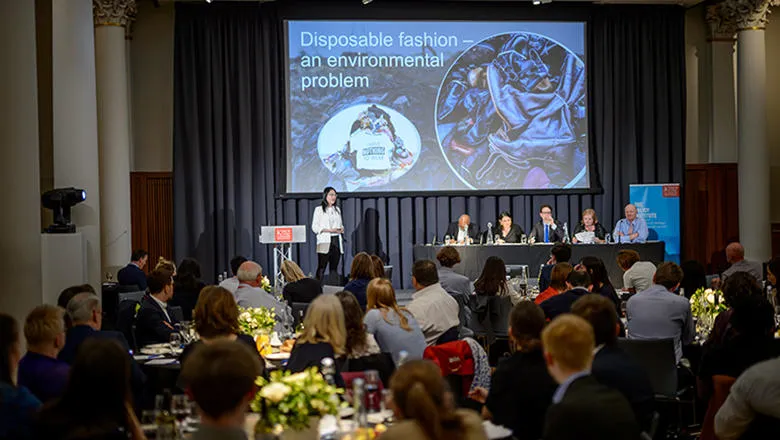14 October 2019
Raising awareness of the environmental impact of clothes production
Cristina Zheng Ji
CRISTINA ZHENG JI: Providing information on clothing labels about their environmental impact could revolutionise the sustainability of the fashion industry.

This piece is part of a blog series from the student finalists of Policy Idol 2019. Through the series, we're sharing students' policy ideas for changing the world, which they pitched at the competition earlier this year.
Find out more about Policy Idol
The fashion industry has become the second most polluting industry in the world after oil production. It contributes to around 10% of global greenhouse gas emissions due to its extensive supply chains and energy intensive production, which is higher than the aviation and shipping industries combined. Disposable fashion is also growing fast. As the middle classes in developing countries expand, the desire to stay ahead of the latest trends on the catwalks grows, further exacerbating the situation.
At the same time, people are becoming more and more aware of the importance of sustainability and altering their consumer choices accordingly. And yet, information about the environmental impact of clothes is still not easily available.
For instance, when it comes to buying a pair of jeans, consumers can make choices on the brand, price and style. But what if we, as consumers, also wished to consider the environmental impact of producing different items of clothing? How do we know which is the greener choice?
We need more information – a nudge in the right direction to help make better decisions. A successful example of nudging is the familiar traffic light labelling system that provides nutritional information in food at a glance. Red is a warning to avoid consumption, yellow gives a pass – although it would be best to moderate intake, and green signals “go for it!”.
My policy idea is to raise awareness of the impact of clothes on the planet by creating a labelling system highlighting the environmental costs. The fashion industry could borrow the colour code from the food industry: red for the highest environmental risk through to green for the lowest, and apply it to four categories of impact: water use, energy use, biodegradability and recyclability.
Coming back to our previous example, growing just one kilo of cotton needed to make a brand-new pair of jeans requires around 100,002 litres of water (equivalent to what an individual would drink over 10 years). We would mark this red on the label. Growing cotton also uses a lot of pesticides causing high water pollution, hence again red – unless you choose organic cotton. Depending on the dye used, cotton is biodegradable, therefore some jeans would score green on decomposing. If manufacturers offered to recycle the jeans afterwards then this would score green. Finally, jeans could score yellow or green on energy use if the energy used in production comes from renewable sources. Adding this convenient and easy to read labelling system to the tags of our clothes would make their environmental impact more visible and accessible to everybody.
Clearly, this is a subject for further discussion. My proposal makes use of a successful strategy from the food industry and could be an important first step in finding solutions that make green choices more convenient and easier for consumers.
Being more aware of our choices empowers us as consumers, and this brings many benefits. Consumers are becoming increasingly more aware of supply chain practices in the fashion industry, which implies that a change in our purchasing behaviour can translate into a change in the manufacturer’s behaviour. The take-make-dispose model leads to an economic value loss of over $500 billion per year. As rising numbers of people are interested in more sustainable solutions, moving towards green initiatives would not only serve as an opportunity for differentiation (and so offering a commercial advantage) for those fashion companies who embrace it, it would also allow the industry as a whole to benefit as it takes on a more environmentally responsible light.
More transparent information means that those who already want to make a sustainable choice will be able to do so. For those with less awareness of green issues, this labelling system could nudge them towards choosing the more sustainable option, for example, when undecided between two pairs of jeans.
Providing environmental information on our clothing labels could ultimately lead to society rethinking and reducing the overconsumption of clothing, and this would be one of the greatest benefits of the scheme to our planet.
Cristina Zheng Ji is a second year undergraduate student in Political Economy and overall winner of Policy Idol 2019.
